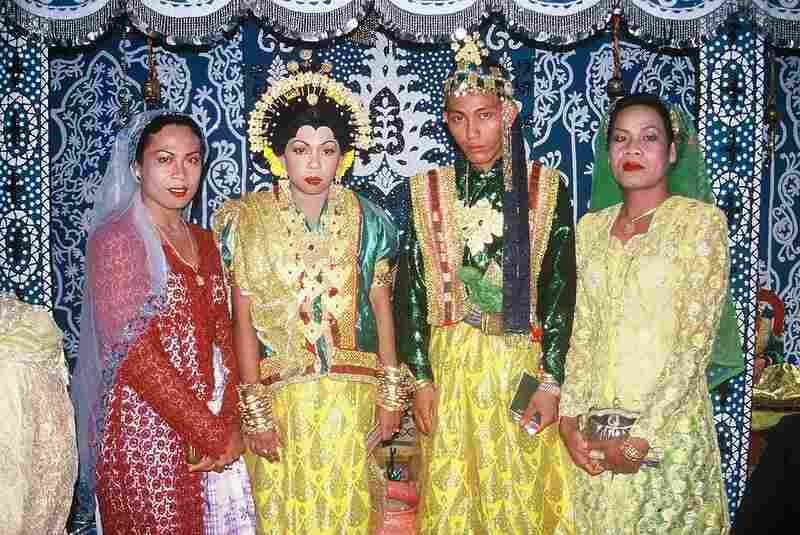Gender in Bugis society
Gender in Bugis society, they recognize five different genders: Makkunrai, Oroani, Calalai, Calabai and Bissu correspond to five ways of being in the world.
The Bugis people are the most numerous of the three major ethnic groups in South Sulawesi, Indonesia, with around 3 million people. Most Bugis are Muslim, but many pre-Islamic rituals continue to be honored in their culture, including the idea that gender exists on a spectrum. Most Bugis converted from animism to Islam in the early 17th century; a small number of Bugis have converted to Christianity, but the influence of Islam is still very strong in their society.
1. Oroane
Oroane are comparable to cisgender men (someone whose gender identity matches the sex they were born with)
2. Makkunrai
Makkunrai to cisgender women (someone whose gender identity matches the sex they were born with)
3. Calabai (transgender women)
According to the Bugis gender system, calabai are usually assigned to males at birth, but assume the role of heterosexual females.
Their fashions and gender expression are distinctly feminine but do not match those of “typical” cisgender women.
Calabai are born with a male body but have female roles, wear dresses and make-up, and have long hair.
Calabai embrace their femininity and live as women, but do not see themselves as women, do not wish to be women, or feel trapped in a man’s body, and they are respected by society. They are supported by family and men accept them as men, living in a female embodiment.
4. Calalai (transgender men)
The calalai are assigned a female at birth, but assume the roles of heterosexual males. They dress and pose as men, hold male jobs, and usually live with female partners to adopt children.
The calalai take on traditionally male roles: they can wear shirts and pants, smoke cigarettes, have short hair and perform manual trades.
5. Bissu
Bissu are androgynous or intersex and revered shamans or community priests.
Who are the Bissu? (androgynous or intersex and revered shamans or community priests)
The term Bissu, which designates a “transcendent gender”, applies, within the beliefs of the Bugis of South Sulawesi in Indonesia, to an individual who is neither male nor female (Wikipedia).
Many Bissu are born intersex, but the term has implications beyond biology. While the Bugis gender is often described as a spectrum, the Bissu are said to be above that classification: spiritual beings who are not midway between masculine and feminine, but rather embody the power of both to that time.
Going further, the Bissu deliberately dress in a way that blends traditional masculine and feminine characteristics (such as carrying a traditionally masculine knife while wearing flowers in their hair). They have existed in Bugis culture since long before the arrival of Islam in Indonesia in the 13th century.
Even today, Bissu play an important role in local communities by providing blessings at weddings, before harvests and even before Bugis Muslims make the pilgrimage to Mecca. For the Bugis, the Bissu are not only a mixture of masculine and feminine, they are also a mixture of mortal and divinity, capable of becoming possessed by spirits through elaborate and dangerous rituals. They are seen as intermediaries between the worlds and occupy a shaman-like role in the Bugis religion.
Special characteristics
To become Bissu, one must present particular signs, for example an umbilical cord in the shape of a snake and which cannot be cut. Sometimes the person is also possessed with a spirit, resulting in disordered behavior or great silence.
His initiation within the community will go through the learning of liturgical texts, dance and songs.
The Bissu are transvestites and the possible explanations are rather diffuse: transvestism would recall mythological androgyny (feminine and masculine); each sacred object has a gender, masculine or feminine; this is why the Bissu in charge of the arajang must be ambivalent (bifurcated contradicting each other).
A complex relationship with their image
Although their religious rituals and understanding of gender are steeped in pre-Islamic ideas, most Bugis are Muslim, and many are devoutly so. There were complex interactions between Bugi values and Islamic teaching. This led to forms of Islamo-Bugi syncretism.
Many calalai and calabai struggle with their sexuality and sense of identity, she also noted, believing that their lifestyle (which can include same-sex relationships) is a sin according to Islamic belief, but also that they are as they are because Allah has ordained it.
For the same reason, they do not have the concept of being born in the wrong body; although some calabai may undergo cosmetic procedures to look more feminine, they do not consider themselves women.
Previously tolerated in society, their status changes
Within Bugis society, calabai and calalai may be frowned upon in some quarters, but they are widely tolerated, even seen as playing an important role in society, and are generally not attacked or otherwise persecuted by their own community.
However, we can only emphasize their importance in Indonesian culture and their influence in various fields. Although there are only 6 million in a country of 270 million people, “The Bugis are among the most powerful ethnic groups in the archipelago, politically, economically and culturally,” said Sudirman Nasir, a Bugi who works in public health in South Sulawesi. The Bugis people of South Sulawesi are a powerful ethnic group, notable for their recognition of five distinct genders. But the future of their unique culture looks bleak.
A third gender known as waria… A compound of wanita, meaning female, and pria, meaning male… Has long been recognized in Indonesian societies. However, since the mid-20th century, Indonesian society as a whole has become less tolerant of non-binary ideas about gender. This led to persecutions against the Calabai and the Bissu in particular.
Beginning in the 1950s, a wave of violent attacks began against the LGBTQ community.
Read also: Kiyoshi Kuromiya | Anti-war, gay liberation, and HIV/AIDS activist
Conflicts with the arrival of Islam
Serious conflicts appeared from the XVIIth century and a compromise passed by a redistribution of the tasks. The Bissu became guardians of the arajang and healers while the imams were in charge of religious values.
However, there are synthetic texts where the last hero of La Galigo is reborn as Muhammad! The goals of the two beliefs are not contradictory, however. The Bissu seek to communicate with the supernatural. Whereas Islam is a bond that is woven between the individual and Allah. But they suffered many persecutions in the 60s and 70s.
What is their role in today’s society?
With the disappearance of the courts, the role of the Bissu has lost much importance. Some branches of a rigorous Islam have also contributed to the decrease in vocations… so the Bissu will make the pilgrimage to Mecca… and ask for the protection of the Arajang before leaving!
They can offer their blessing and serve as diviners for certain events (rain, drought, love…). The Bissu are numerous to hold hairdressing salons or to organize wedding ceremonies. But are they still Bissu in this context?
They are now recognized by the government, which calls on their services … especially in Watampone … For the city’s anniversary. Indeed, the Arajang of the hero Arung Palakka are duly revered and this can only concern the Bissu. The future, however, remains a big question mark.
A rapprochement with the LGBTQ community criticized
Unfortunately, the Bissu have been persecuted and repressed under Islamic fundamentalist and communist regimes. This was after Indonesia’s independence from Dutch rule in 1949. A 2015 Al Jazeera article detailed anthropologist Halilintar Lathief’s efforts to revive the presence and role of the Bissu in Bugi communities, inaugurating the first new Bissu in decades in 2002.
In the town of Sigeri, for example, “being Bissu is now tied to gay and transgender identity”, although many consider becoming a Bissu a pointless ordeal as calabai and other non-binary individuals now have greater economic opportunities working in salons or as wedding planners.
Around the world, individuals who identify outside of the gender binary are seeing growing legal and social recognition. In particular, it will be recalled that in 2014, South Asia’s 4,000-year-old third-gender hijra community won a bitter victory when India’s Supreme Court declared discrimination against hijra illegal and instituted a third gender option on government documents (hijras also got this right in Nepal, Pakistan and Bangladesh). There are still many institutions where the gender binary remains the only option. But these progressive steps are extremely meaningful for those affected.
Spources: PinterPandai, JSTOR, BBC, Wikipedia (English), Akkadium College of Education, The Australia-Indonesia Centre (AIC)
Photo credit: Sharyn Davies / Flickr (CC BY 2.0)



